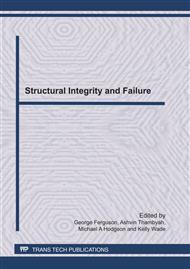p.43
p.47
p.51
p.55
p.59
p.65
p.69
p.73
p.77
Low Cycle Fatigue Behavior of Ni-Base Superalloy IN738LC at Elevated Temperature
Abstract:
High strength nickel-base super alloys have been used in turbine blades for many years because of their superior performance at high temperature. The prediction of fatigue life for superalloys is important for improving the efficiency. In this study, low cycle fatigue tests are performed the variables of total strain range, and room and elevated temperature. The relations between plastic and total strain energy densities and number of cycles to failure are examined in order to predict the low cycle fatigue life of IN738LC super alloy. The fatigue life is evaluated by the Coffin-Manson equation, also the predicted lives by plastic and total strain energy density are compared with experimental results.
Info:
Periodical:
Pages:
59-62
Citation:
Online since:
July 2011
Authors:
Price:
Сopyright:
© 2011 Trans Tech Publications Ltd. All Rights Reserved
Share:
Citation:


